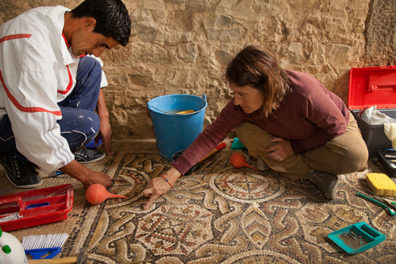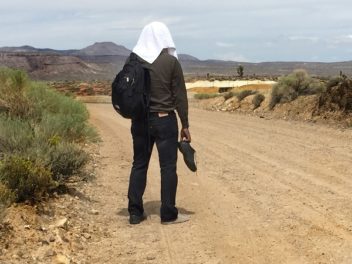
Sajjad Sharifi during the earthen architecture course’s laboratory exercise about basic testing to characterize and classify a given earth sample.
People across the world have used earth, clay, and other such materials to construct buildings for thousands of years—from ancient times today. These earthen structures exhibit a huge variety in size, style, and building techniques.
Training opportunities in best practices of earthen architecture conservation, especially those addressing earthen architecture in the Middle Eastern, North African, and South Asian regions, are greatly lacking. A monthlong course held in October 2018 in the World Heritage City of Al Ain in the Emirate of Abu Dhabi was a rare opportunity for professionals to spend four weeks immersed in the conservation of earthen architecture. Organized by the Getty Conservation Institute and the Department of Culture and Tourism–Abu Dhabi, the course brought together architects, engineers, archaeologists, and conservators from the regions of the Middle East, North Africa, and South Asia responsible for the care of earthen structures to further their knowledge in current best practices and help build a global network of experts.
Early in the course Angela spoke with several participants to hear about the particular challenges they face back home in working with earthen architecture and what they hoped to learn from the course. Each cast light on the diversity of earthen building techniques and types and the specificity of conservations issues they face, as well as on their shared sense of the urgency and importance of this work for preserving their cultural heritage.
Sajjad Sharifi –UNESCO, Afghanistan
Sajjad Sharifi is an urban planner in UNESCO’s office in Kabul, which supports Afghanistan’s government and universities by providing training and courses for professionals and students. Previously he worked for the Ministry of Urban Development and Housing on the Dural Aman Palace Restoration project and at the Urban Research and Development Center.

Sajjad (standing at center) mentoring urban planning students at UNESCO’s Kabul office. Courtesy of Sajjad Sharifi
What types of conservation issues are you dealing with in your work?
We are facing rapid urbanization in Afghanistan. This is visible in the landscape—in the materials used for new construction. These urbanization activities are causing damage to historic buildings—damage to buildings that have not been documented. We have some records, but these building have not really been documented in a way that can help us move forward with our conservation work.

A view of the Old City from the Citadel in Herat, June 2011. Licensed through a Creative Commons Attribution-NeDerivs 2.0 Generic license (CC BY-ND 2.0). Source: US Embassy Kabul Afghanistan
In the Old City of Herat, which is being eaten away by urban development, our project is looking at two types of historical buildings: sarays, which were government buildings with special importance, and karvansarays, which were built for trade and as rest stops for travelers. Unfortunately, these buildings are now being used as storage, but we’ve prepared a road map of how to address that.
We’re also undertaking work in the larger city of Herat, where we will be creating an inventory of the urban center to find and study historic buildings and historic monuments. From there, we will develop planning for the city.
What are the threats to the earthen heritage in your region?
We have many challenges for protecting heritage. Lack of awareness about the importance and value of heritage is a very big threat, in addition to natural hazards destroying our historic monuments.
It would also be helpful if the government could give more attention to the preservation and protection of heritage, but unfortunately, they are struggling with security issues all around the country.
What skills or knowledge are you hoping to acquire through this course?
I’m an urban planner not an architect or archaeologist, but I still need to know how to study earthen architecture for my work. I applied for the course because I wanted to get a better understanding of documentation and documentation methods and to bring this knowledge back to Afghanistan and my work.

The site of Mes Aynak, Logar Province, July 2011. Licensed under a Creative Commons Attribution-ShareAlike 3.0 Unported license (CC-BY-SA 3.0). Source: Wikimedia Commons
There is an archaeological site in Logar province called Mes Aynak. Archaeologists are working at the site, but it is also home to a working copper mine. The Ministry of Information and Culture, which is responsible for the site, is talking with different departments and different organizations on how best to balance these concerns. A healthy economy is really important for us, but so is the conservation of the archaeological site. With the knowledge I’ve acquired in this course, perhaps in the future, I may be able help to assist with the decision-making and to determine how to conserve this site.
Do you have a favorite building or site?
For me, Bamiyan is really special. The Bamiyan Valley is a unique landscape; we have many monuments, Qoqola town, and Zohak town, and the Buddha statues, which are now ruins.

The Bamiyan Valley in June 2012. Source: Wikimedia Commons
UNESCO has a new project in Bamiyan, which will be supported by the Italian Agency for Development Cooperation, to strengthen Afghanistan’s capacities to preserve and manage the cultural landscape of the Bamiyan World Heritage site. This includes the proposal of an archaeological park, which would be built in front of the ruined Buddhas.
In the future, I hope we can continue to have programs and activities to make the situation better.
_____
Read interviews with other participants in the earthen architecture course who work in China, India, and Oman.




Comments on this post are now closed.